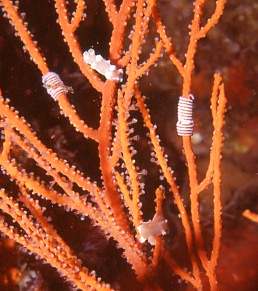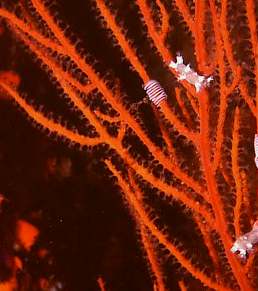Tritonia nilsodhneri colour
May 8, 2003
From: Ricardo Roberto Fernández


Dear Dr. Rudman,
I am reading all the information related to the species that I have recorded with my camera and I have found the discussion about the colour of Tritonia nilsodhneri quite interesting. Although it can match the colour of the gorgonian on which it lives, sometimes it lives on gorgonians of quite a different colour and keeps its white colour. The images I am enclosing were taken in Asturias, on the Northern coast of Spain (close to Galicia) and there are two individuals with their egg masses on what I think it is Lophogorgia ceratophyta (= Leptogorgia sarmentosa). As you can see, they don't match at all the colour of the gorgonian, so I wonder if they don't rely on colouur defences for surviving. Could it be that they get the colour of the gorgonian gradually, so when they arrive on a new one it takes them a while to get sufficient pigment from the new host? If so, wouldn't they be in danger for too long? This is why I think they might rely on some other defences. What do you think?
Best wishes and thank you very much for your wonderful site,
Ricardo Roberto Fernández.
rirober@telecable.es
Dear Ricardo,
You raise some interesting questions. Have you seen the section on colour in nudibranchs. Some of your questions are discussed there. Certainly some nudibranchs get their pigment from their food so are very well camouflaged, although in species such as the sponge-feeding Rostanga arbutus, they also have bristles all over he back so when they crawl off the sponge and are no longer hidden, they are disguised as a small bit of inedible sponge.
But to your tritoniids. I am not sure if anyone has studied whether the pigment in this species is from their food or a result of their own genetic makeup. Without some experimentation its not possible to say if the presence of one or two pink animals amongst a large population of grey animals on a grey gorgonian, means they are recent arrivals still trying to change colour, or just a couple of animals which are showing the 'pink' phase of the species genetic makeup. If it is genetic, then although it may make life a little dangerous for them, the pink ones are incredibly valuable for the species because they are the variation which gives the species the chance to survive in an area where only pink gorgonians exist.
About other defences. Gorgonians have a great store of nasty chemicals in their tissues, and often gorgonian feeders incorporate some of these chemicals in their own tissues to deter potential predators. Again I am not sure if Tritonia nilsohdneri has been examined for such chemicals but I suspect it probably has such
anti-feedant chemicals in its skin as a second line of defence.
Best wishes,
Bill Rudman
Related messages
-
Tritonia nilsodhneri feeding and laying eggs
From: Dominique Horst, April 14, 2010 -
Re: Food and colour in Tritonia nilsodhneri
From: Ricardo Roberto Fernández, October 6, 2009 -
Re: Tritoniid on gorgonian - Portugal
From: Alma Sánchez Santos, April 30, 2008 -
Tritoniid on gorgonian - Portugal
From: Joao Pedro Silva, April 23, 2008 -
Tritonia nilsodhneri from Guernsey
From: Richard Lord, July 16, 2003 -
Tritonia nilsodhneri from Mediterranean
From: Marina Poddubetskaia, August 5, 2002 -
Re: Food of Tritonia nilsodhneri
From: Helmut Zibrowius, October 24, 2001 -
Tritonia nilsodhneri in NE Atlantic
From: Bernard Picton , October 18, 2001 -
Tritonia nilsodhneri from Spain
From: Bernard Picton , October 18, 2001 -
Tritonia nilsodhneri from Turkey
From: Baki Yokes, October 3, 2001 -
Food and colour in Tritonia nilsodhneri
From: Jane Lilley, May 10, 2001 -
Tritonia nilsodhneri from Spain
From: Erwin Koehler, June 1, 2000
